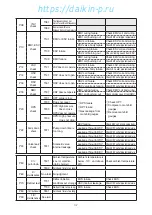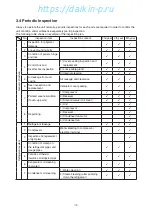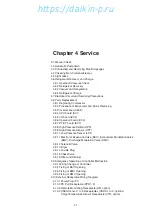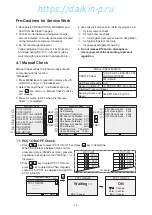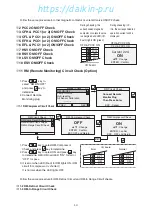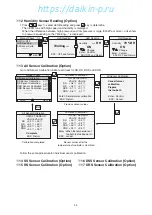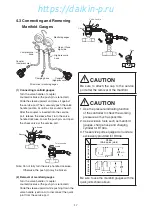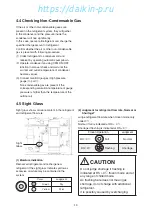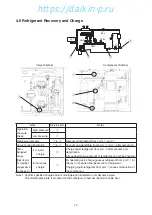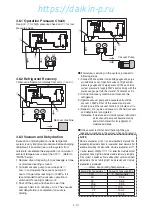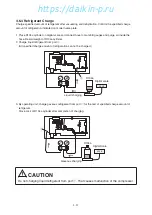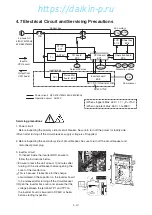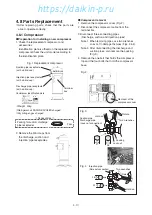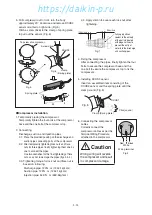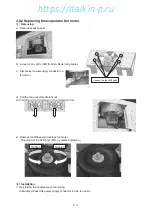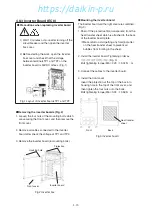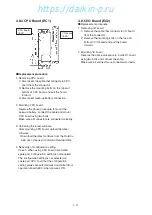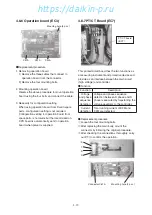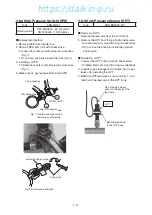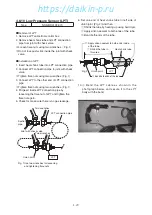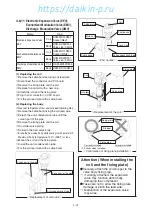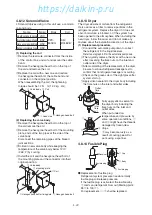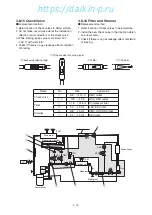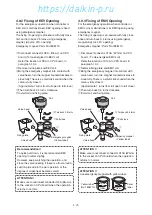
4-10
4.6.1 Operation Pressure Check
Use port
②
for high pressure check and
①
for low
pressure check.
①
②
LP
HP
4.6.2 Refrigerant Recovery
1. Recover refrigerant completely from ports
④
and
①
.
④
①
Recover machine
4.6.3 Vacuum and Dehydration
Evacuation and Dehydration inside refrigerant
system is very important procedure before charging
refrigerant. If possible, heat up the system from
outside to accelerate the evaporation of moisture if
ambient temperature is lower than 15
℃
. (Refer to
"NOTE" below.)
1. Replace dryer if repairing for gas leakage is done
or moisture inserting is found.
2. Connect vacuum pump to service ports
①
and
④
and operate the vacuum pump for 1
hour or longer after reaching to -100kPa. It is
recommended that the vacuum operation is
switched ON overnight after work.
3. Shut off the pump and check to see if the
vacuum holds for 5 minutes as it is. The vacuum
and dehydration is completed if vacuum is
holding.
④
①
Vacuum Pump
0
●
If moisture is existing in the system, proceed to
following steps.
1) Connect R134a cylinder to manifold gauges and purge
air inside the hoses. Open both valves of high and low
pressure gauges and charge gaseous R134a and raise
system pressure to roughly 20kPa by monitoring with the
compound gauge. Hold this state for 15 minutes as it is.
2) Connect recovery machine and recover the
refrigerant.
3) Operate vacuum pump and evacuate unit until the
vacuum -100kPa. Shut off the vacuum pump. and
check to see if the vacuum holds for 5 minutes as it is.
4) Repeat 1),2),3) again and vacuum is still held, vacuum
and dehydration is completed.
Reference: If moisture exists inside system, lubrication
oil for vacuum pump will become muddy
and whitish. Refer this for judgment of
moisture existence.
●
If the vacuum is still not held, there might be gas
leakage somewhere in the system. Check and repair it.
NOTE
Moisture evaporates at 100
℃
under atmospheric pressure. The
evaporating temperature drops to lower under lower pressure. For
example, according to below table, moisture evaporates at 11.7
℃
under vacuum -100kPa. If 11.7
℃
or lower, the moisture will not
evaporate and ice might form before moisture removal is complete.
If the system is heated up from outside under such low ambient
temperature, the ice forming might be prevented and moisture
evaporation is accelerated.
-----Water, Evaporating Temperature------
Evaporating Temperature
℃
Vacuum pressure kPa
100
0
(
Atmospheric
)
40
−
93.6
30
−
96.5
20.6
−
98.9
11.7
−
100
7.2
−
100.2
0
−
100.6
04章̲LX10F11B3̲TR16-02̲En.indd 4-10
04章̲LX10F11B3̲TR16-02̲En.indd 4-10
2016/02/03 16:22:03
2016/02/03 16:22:03
https://daikin-p.ru
Summary of Contents for LX10F11B3
Page 7: ...https daikin p ru ...
Page 83: ...https daikin p ru ...
Page 93: ...https daikin p ru ...
Page 121: ...https daikin p ru ...
Page 129: ...https daikin p ru ...
Page 138: ...6 9 6 6 Sequence AIR WATER COOLED AIR WATER COOLED https daikin p ru ...
Page 139: ...6 10 Stereoscopic wiring diagram AIR WATER COOLED https daikin p ru ...


